23 Feb Drape Cape Top
As a general rule, capes and ponchos are not at the top of my shopping list. I know they are currently on-trend but I find so many of them to be either unattractive or impractical. We don’t have cold enough weather here to benefit from the traditional wool cape with cozy hood or wrap. However, the more recent lightweight, knit designs in shrugs and capes are probably a lot easier to wear and may even have a functional place in our trans-seasonal wardrobes. If you’d like to learn my method for creating Twist Drape Patterns I have a detailed worksheet for making Jersey Twist Patterns. For just a few dollars you’ll get the same training you’d get if you came to the workshop in my studio.
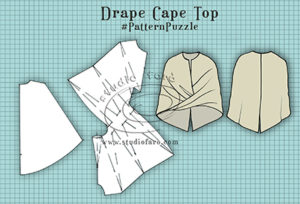
This design was inspired by a few catwalk cape-style tops that have also featured drape detail. So I decided that I would bring our Single Twist Pattern Making Technique to this particular design challenge and see if I could produce an attractive Draped Cape.
Natalie Bray was my first stop to refresh my understanding of how to make a cape pattern. After all it’s not something I do every day. On page 127 of ‘More Dress Pattern Designing’ Natalie starts with a coat block and provides a set of detailed instructions to make a cape pattern as outerwear.
However our design is barely outerwear but more likely to be the first layer of clothing (after a light tee). So I started with my fitted dress block and made the following changes:
- Transfer the shoulder and bust dart through to the hip line on the front and back fitted block. We will not be using the waist darts at all for this pattern.
- Place the CB (centre back) line of the back block at a right angle to the CF (centre front) line of the front block, with Shoulder Points (SP) touching.
- Draw a line from the connecting shoulder points through to the hemline area, half way between the front and back blocks. In a half-circle cape style this is considered the side seam.
- Now redraw this line either side of the side seam to reduce the width in the hemline of our cape design. We will need a slightly firmer fit in the cape hem to get the best results for our twist drape.
- Mark in the length of your top, just below the waist line in the high hip area, from the front through to the back.
- Now dip the back hem to just past the hip line. This will produce a Hi-Lo effect in the hem of our garment.
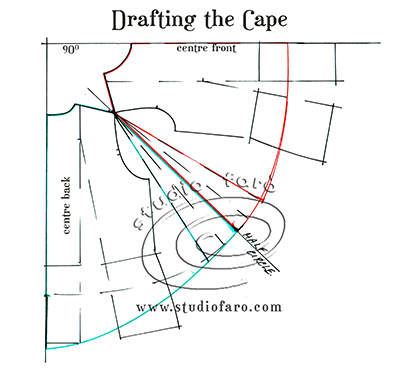
To develop the drape detail in the front cape you will need to trace a full front cape pattern as below. And then:
- On the CF line mark in the front neck opening 12-15cm.
- Mark in the twist drape cut lines as indicated in the diagram below.
- Please note that there are two tucks in the CF opening that are sewn down tucks and not part of the twist move. One lines up with the CF opening and the other is directed from the CF line to the left shoulder point.
- Open up the front pattern to introduce extra fabric for the twist drape.
- Mark out the CF tucks and open to include the under tuck area for both.
- Please note that the front right and front left are separate pattern pieces at this time.
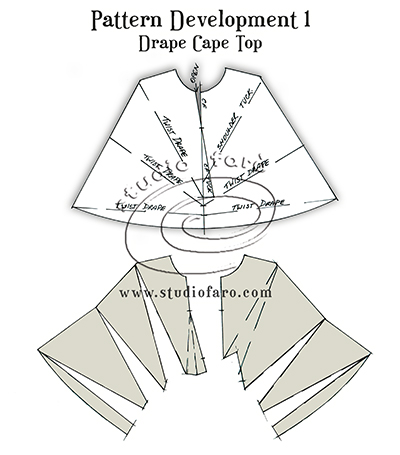
To finalise the front pattern, turn the left side front upside down and connect to the right side front in the waist to hip area (where the twist is located). Allow some extra fabric in the middle of the twist and connect both CF seams back to the hemlines with a gentle curve. As a single twist pattern you will need to use a cloth that is good both sides for it to work well.
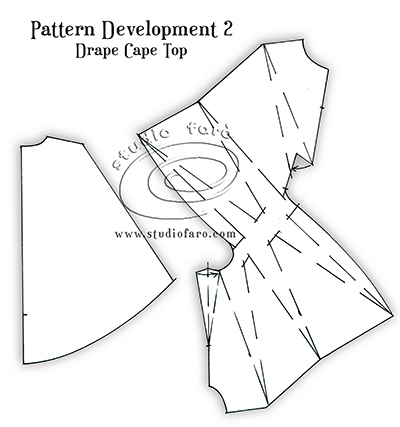
For the final pattern pieces I have kept the grain line with the CF and CB lines. This will then place the bias of the fabric in the area of the twist drape for best results. The finish for the neckline and opening would generally be a facing. Bound edges would also work.
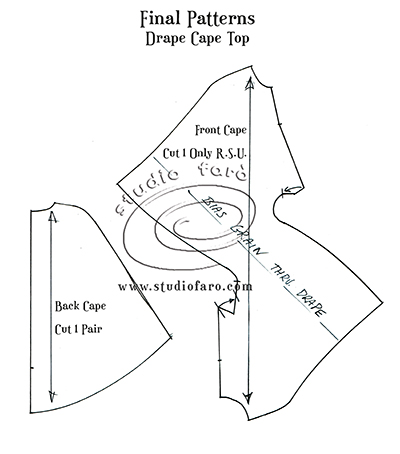
For me, these blog posts are always a delightful end to a great weekend of pattern making nerdiness and they always leave a smile on my face. So huge thanks to all and feel free leave your questions in the comments section below. Always happy to hear from you. If you’d like to buy a copy of these pattern making notes for your own personal use at home you’ll find them here: Drape Cape Top – Pattern Making Instructions. 🙂
Take this moment to sign up for my fabulous newsletter! Every month or so I send an email newsletter with new website content and always, always an enormous discount code for all my sewing patterns, garment blocks and pattern making instructions.
This discount code is for subscribers only. Don't miss out!


No Comments